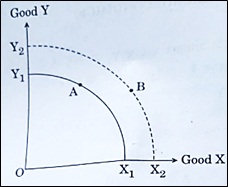Economics : 2019 : CBSE : [All India] : Set 3
To Access the full content, Please Purchase
-
Q1
Shift from point A on Production Possibility Curve X1Y1 to Point B on X2Y2 in the given figure indicates: (Choose the correct alternative)

(a) Decrease in resources
(b) Increase in resources
(c) Full and efficient utilitsation of resources
(d) Wastage of resources
Marks:1View AnswerAnswer:
(b) Increase in resources
Explanation:
In the given figure, PPC has shifted to right at all points, it implies that the production of both the goods has increased at given the level of technology.
-
Q2
A Production Possibility Curve (PPC) would be convex to the origin if Marginal Rate of Transformation (MRT) is ______. (Fill up the blank)
Marks:1View AnswerAnswer:
decreasing
Explanation:
Marginal Rate of Transformation = Δ Y/ Δ X is continuously decreasing. It implies that in order to produce more of one good X, we have to sacrifice more units of good Y.
-
Q3
Mention any two examples of implicit cost incurred by a firm.
Marks:1View AnswerAnswer:
The two examples of the implicit cost incurred by a firm are as follows:
- Use of own building for production purposes by factory owner, and not receiving rent.
- Use of own capital to purchase machinery for the production and not charging any interest
-
Q4
Define variable cost.
Marks:1View AnswerAnswer:
The expenditure made on the purchase of a variable factor of production or to hire casual labourer is termed as variable cost.
-
Q5
The coefficient of price elasticity of supply of a good is 3. It is known as _________. (Choose the correct alternative)
(a) Unitary Elastic Supply
(b) Perfectly Inelastic Supply
(c) Elastic Supply
(d) Inelastic Supply
Marks:1View AnswerAnswer:
(c) Elastic Supply
Explanation:
When there is more percentage change in quantity supplied due to a percentage unit change in price, it is known as elastic supply.
-
Q6
The shape of the average revenue curve under perfect competition would be ________. (Fill up the blank)
Marks:1View AnswerAnswer:
parallel to X-axis
Explanation:
The shape of the average revenue curve under perfect competition is parallel to X-axis. It is because in perfect competition, commodities are sold at uniform prices and the price is equal to marginal revenue which is equal to average revenue.
-
Q7
Discuss the relationship between total utility and marginal utility, using a hypothetical schedule.
Marks:3View AnswerAnswer:
Total utility is defined as the total psychological satisfaction derived from the given stock of the commodity consumed. It can be estimated as the sum total of marginal utilities derived from the commodity.
TU =∑MU
Marginal utility is defined as the utility derived from the additional unit of the commodity consumed. It can be estimated as the change in TU due to change in one unit of the commodity consumed.
MUn = TUn - TUn – 1
For example, if the consumption of first unit of the commodity gives the satisfaction of 20 utils and the consumption of the second unit of the commodity gives 15 utils of satisfaction, then the total utility derived from consumption of one commodity is 20 utils and from consumption of two commodities will be 35 utils and the marginal utility for the consumption of the second unit will 15 utils.
Unit MU TU 1 20 20 2 15 35 3 12 47 4 10 57 -
Q8
Discuss briefly the central problem of "What to produce".
Marks:3View AnswerAnswer:
"What to produce" is defined as the problem of allocation of resources or the problem of choice between different commodities say, consumer goods or capital goods that can be produced. It also deals with the problem in what quantity the goods should be produced with the scarce resources.
The problem of "what to produce" is closely related to the problem of resource allocation.
- It depends on the pattern of demand and the availability of resources.
- Choosing a particular commodity to produce means allocating resources in the production of that commodit.
-
Q9
Classify the following statements into positive economics or normative economics, with suitable reasons:
(a) Consumer price index presents a more realistic picture of the inflation rate in a country than the wholesale price index.
(b) Subsidies should be offered very carefully.
Marks:3View AnswerAnswer:
(a) Positive Economics
Reason: Positive statements describe what was, what is and what would be under the given set of circumstances. All the statements are verified empirically.
In the given situation, the consumer price index presents the inflation rate in India which can be verified with available data.
(b) Normative Economics
Reason: Normative economic analysis describes “what ought to be”. Its objective is to determine the norms. Normative statements pronounce value judgment or an opinion relating to right or wrong of a particular policy matter and it is always a matter of debate. -
Q10
The price of commodity increases from ₹ 10 to ₹ 14. Calculate percentage fall in quantity demanded of the commodity if the coefficient of price elasticity of demand is (-) 1.25.
Marks:4View AnswerAnswer:

where Ed = coefficient of price elasticity of demand
ΔP = change in price ; ΔQ = change in quantity demand
P = Original price and Q = Original quantity
Given, % change in price= ΔP x 100/P=4x100/10=40%
% Change in quantity demand = %ΔQ
Ed= 1.25
1.25 = %ΔQ/40%
%ΔQ = 1.25x40% =50
Thus, the percentage change in quantity demanded is 50.



